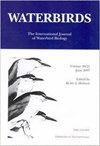在一个关键的非繁殖区建立一个站点网络来维持哈德逊鹬(利马沙)的重要性
IF 0.6
4区 生物学
Q3 ORNITHOLOGY
引用次数: 1
摘要
许多滨鸟依靠一组关键地点来完成它们在飞行路线、区域和景观尺度上的年度循环。智利chilo本文章由计算机程序翻译,如有差异,请以英文原文为准。
The Importance of a Network of Sites to Maintain Hudsonian Godwits (Limosa haemastica) in a Critical Non-Breeding Area
Many shorebirds rely on a set of key sites to complete their annual cycles at the flyway, regional, and landscape scales. Coastal wetlands on Chiloé Island, Chile, (Chiloé) support a high proportion of the Hudsonian Godwits (Limosa haemastica) spending the boreal winter along the Pacific coast of the Americas. We conducted annual counts of godwits on Chiloé between 2010 and 2020 to estimate trend in the population. To understand use of individual sites and local networks of sites (clusters), we conducted monthly counts September 2013–March 2014 and September 2017–March 2018. Because of wide variation in annual counts, we did not detect a significant trend in abundance of godwits on Chiloé. Mean monthly abundance summed across all sites during December–February varied markedly among site clusters, with godwits being most abundant in the central Chiloé cluster. Across Chiloé, variation in monthly counts of godwits at individual sites was twice as great as variation in counts summed within a cluster. Casual re-sightings of color-flagged godwits supported the idea that godwits used clusters consistently across years. Our results illustrate the importance of conserving a network of sites across multiple scales as an important step in maintaining Hudsonian Godwit populations.
求助全文
通过发布文献求助,成功后即可免费获取论文全文。
去求助
来源期刊

Waterbirds
生物-鸟类学
CiteScore
1.30
自引率
0.00%
发文量
0
审稿时长
6-12 weeks
期刊介绍:
Waterbirds is an international scientific journal of the Waterbird Society. The journal is published four times a year (March, June, September and December) and specializes in the biology, abundance, ecology, management and conservation of all waterbird species living in marine, estuarine and freshwater habitats. Waterbirds welcomes submission of scientific articles and notes containing the results of original studies worldwide, unsolicited critical commentary and reviews of appropriate topics.
 求助内容:
求助内容: 应助结果提醒方式:
应助结果提醒方式:


